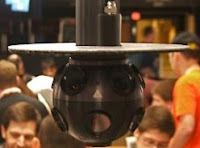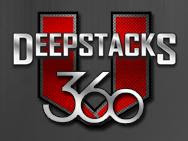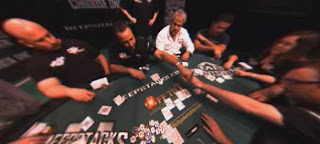Taking DeepStacks360 for a Spin
 Poker instruction has become a complicated, crowded business.
Poker instruction has become a complicated, crowded business. It wasn’t that long ago there were only a handful of good books out there, plus a couple of forums where one could read about strategy and perhaps participate in conversations about how to play the game. Not only are there a lot more books and forums today, but other types of instruction have emerged, too, including “boot camps” and live seminars, as well as video-based tutorials available online via subscription.
Being a “book guy,” most of my away-from-the-table poker study has been confined to reading books and magazines, although I have looked at a few vids and can see how valuable they can be. (One of those things I keep intending to spend more time pursuing, although I’ve yet to find the time to do so.) I also can see how those who aren’t crazy about reading -- or “visual learners,” as some educators like to call such students -- would prefer and probably get a lot more out of the video-based instruction model.
I had a chance yesterday to look in on another type of poker teaching, one that kind of combines the video lesson idea with the live seminar. It took place over at DeepStacks360.com, a lengthy (five-hour) seminar of sorts dubbed “Michael ‘The Grinder’ Mizrachi’s WSOP Final Table Power Poker Course.”
 Some may recall those “All360Poker” cameras from this summer’s WSOP. Touted as “the best thing since the hole card camera,” the technology really is pretty cool (in my opinion) for viewing above-the-table poker. Using a special camera with 11 different lenses which is positioned over the center of the table, the resulting video is interactive in that the viewer can use the mouse to pan all of the way around the table, tilt up or down, or zoom in and out. The kind of thing some might have seen on real estate or hotel websites, allowing prospective buyers/renters to get a full “360° view” of rooms.
Some may recall those “All360Poker” cameras from this summer’s WSOP. Touted as “the best thing since the hole card camera,” the technology really is pretty cool (in my opinion) for viewing above-the-table poker. Using a special camera with 11 different lenses which is positioned over the center of the table, the resulting video is interactive in that the viewer can use the mouse to pan all of the way around the table, tilt up or down, or zoom in and out. The kind of thing some might have seen on real estate or hotel websites, allowing prospective buyers/renters to get a full “360° view” of rooms.If you want to read more about how it works, Dan Michalski of Pokerati wrote a piece describing the technology for the WSOP last July titled “Poker in the Round.” You can see it for yourself, too, as they still have a lot of that footage from the 2010 WSOP archived over on the All360Poker site. For example, click here to see the final hand from Day 8 of the Main Event in which Brandon Steven was eliminated in 10th place.
Anyhow, the 360° guys have teamed up with the DeepStacks University poker training site to produce some online “courses” employing the technology. I think Mizrachi’s “power course” from yesterday might’ve been one of the first -- if not the first -- attempt at such. Was definitely kind of neat to be able to “sit in” (so to speak) on the seminar. I also found it interesting to watch a very cool, relaxed-looking Mizrachi hanging out like that just three short days before the WSOP ME final table is set to begin.
Had a few other impressions to share from what I saw and heard yesterday.
Essentially, the “course” consisted of poker pros Mizrachi, Mike “The Mouth” Matusow, Tristan Wade, and half-dozen amateur players sitting around a table playing a sit-n-go. The stacks began quite deep (300 big blinds, I think), and the blinds/antes rose quickly enough for them to get through the thing during the scheduled time, thereby covering early, middle, and late stage strategies for tourneys. (I’ll admit I signed off prior to the conclusion last night, so I don’t know how things turned out.)
 With each hand, players kept their cards after they’d folded, then when the hand concluded all turned up their hands and discussion ensued about how everyone had played. A fine model for teaching tourney strategy, I think, which I assume has been used with success in the live seminars.
With each hand, players kept their cards after they’d folded, then when the hand concluded all turned up their hands and discussion ensued about how everyone had played. A fine model for teaching tourney strategy, I think, which I assume has been used with success in the live seminars.There were a few technical problems yesterday. It took me about 20 minutes after the scheduled start time to get the image and sound up and running, and from what I gather I wasn’t the only one having trouble early on. I continued to experience audio drops and image freezes pretty much the entire time I was watching, which sometimes hindered my ability to follow what was happening.
Also, while the 360° cameras do allow one to see all of the players quite well, one can’t really focus on the cards too easily. To compensate, the dealer and players began calling out the cards as they were shown so as to help in this regard, although they weren’t consistent with that and so it was a bit of a struggle at times to know precisely all of the details of a given hand.
That said, there were some interesting moments during the hands I did watch, and I think there is some potential here -- if some of the techy stuff can be smoothed out -- for this type of online instruction to work.
Mizrachi struck me as an especially good communicator and teacher, something I didn’t necessarily expect but was glad to see. Asked a question about tells early on, Mizrachi unhesitatingly responded by saying he looks at opponents’ breathing, posture, how they move their hands, and their bet sizes. He also gave a lot of credence to an opponent’s first reaction to the appearance of a new board card, using that as a guide by which to judge future behaviors.
Mizrachi also shared an interesting theory regarding how best to utilize one’s chips in a tourney, suggesting that one think of one’s stack as in fact three different stacks, with a certain portion (15-20%) reserved for bluffs, another (15-20%) for flips/gambles, and the rest (60-70%) for “solid poker” or chip accumulation. Might be worth remembering that formula come Saturday as we watch him try to build his below-average stack back into a competitive range.
 All three of the pros interacted well with the amateurs. Tristan Wade was the most soft-spoken of the trio, but he seemed to communicate and made useful comments about the amateurs’ play. Matusow was his usual, boisterous self, and while his advice was also mostly fine he seemed frequently to lapse into the old bromides (“tight is right,” “think long, think wrong,” etc.).
All three of the pros interacted well with the amateurs. Tristan Wade was the most soft-spoken of the trio, but he seemed to communicate and made useful comments about the amateurs’ play. Matusow was his usual, boisterous self, and while his advice was also mostly fine he seemed frequently to lapse into the old bromides (“tight is right,” “think long, think wrong,” etc.). There was some interaction happening between the players and those following at home, too. There was a chat box where one could ask questions (with a “premium” subscription, I believe), and the players did respond to some of those along the way.
I definitely think the amateurs sitting at the table benefited from the time they spent with the pros. And I imagine at least some of those watching at home did, too, although like I say technical difficulties may have gotten in the way in some cases.
When it works, though, the 360° camera can be fun and I really do think it might prove a useful way to broadcast live poker. And perhaps even to include folks in these live instructional sessions, too. If you’ve never played with it, do head over to the All360Poker site and see how it works. You can literally tilt the table!
Labels: *the rumble, All360Poker, DeepStacks University, Michael Mizrachi, Mike Matusow














1 Comments:
I followed the poker course yesterday as well. I was happy to get a couple of my questions answered (I bought the premium package) but was frustrated by the initial connection problems and the inability to see the cards. Even though they were calling out the cards it would have been better if I was able refer back to the cards throughout the hands being played. I will say that because of the issue I got a email for them saying they would give me a free course whenever the next one came which was thoughtful. Hopefully, they can fix the bugs by then.
Post a Comment
<< Home